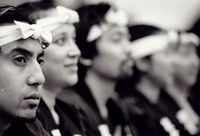Yakudo
Markham Ontario 43° 51' 22.93" N, 79° 20' 15.66" W Arts Media Arts Music Theatre Visual Arts Group
About[edit]
" Yakudo mesmerizes audiences with its inspired stage performance and style unlike any other Taiko group. Festivals and events often request Yakudo due to sheer audience appeal and drawing power. It is evident from their shows that playing Taiko is not just drumming. A performance can range from the dark and mysterious to light and upbeat -- a visual and musical journey that thrills the senses. Yakudo performs with one of the largest collections of authentic Taiko, outside of Japan. This includes their signature and very popular Odaiko - possibly the largest Taiko drum in Canada.
Yakudo is a performing ensemble, which combines the spiritual rhythms of the Taiko with martial arts and contemporary music. Founded in 1992, Yakudo is a non-profit organization, made up of passionate individuals dedicated to the culture and art unique to the Japanese Taiko.
Yakudo's roots are embedded in one of Japan's founding Taiko groups, O-Suwa Daiko. In the late seventies, members of O-Suwa Daiko, visited the Japanese Canadian Cultural Centre in Toronto to share their music and performance. A core of Japanese Canadians were delighted and formed their own Taiko group, Toronto Suwa Daiko, which entertained the community for many years.
In 1992, wanting to take a more independent and professional route, a determined group of young Toronto Suwa Daiko members formed Yakudo - composing their own music and creating their own style. Over the years and through the contributions of many talented Taiko performers and visionaries, Yakudo has progressed and matured its current performing ensemble. Although they have developed a unique and distinctive style, they keep in mind the foundation and tradition of Suwa.
Yakudo is a non-profit organization, promoting Japanese culture through music and performance on Taiko. All the performers are active volunteer members, taking on various roles to keep this group functioning. In addition to performing, all of these talented multi-taskers do a number of behind the scenes work ranging from teaching, composing, promotions, administration, fundraising, booking, performance production and more.
In addition, Yakudo members maintain their collection of Taiko and instruments on a regular basis. Maintenance of these rare and beautiful instruments require a substantial amount of time and patience - re-skinning only one side of a Taiko can take up to 20 hours with 3 to 4 people.
What motivates them? Their affinity of love and passion for Taiko!"[1]
History[edit]
"Taiko are traditional Japanese drums used historically to summon spirits for fortune, strength and harmony. Their powerful sounds are rumoured to shake the earth and heavens above. A mighty thunderous sound yet, much like the sound of a mother's heartbeat to her child, it can be rhythmically soothing. The exact history of Japanese Taiko remains in speculation. Some believe they came from China or India, and were later crafted into the unique instruments they are today. According to some sources, the oldest physical evidence of Taiko in Japan is a Haniwa clay figure of a drummer that dates from the sixth or seventh century.
Taiko drums traditionally had many purposes throughout Japanese history: In religious ceremonies and meditation; for communications - for signalling, community events and setting borders; in battlefield - to signal various formations and to support those in battle; in theatre or dance - as an accompaniment and part of story telling. Today, they are still prominently used in temples, theatre and in festivals all over Japan.
The concept of the Taiko ensemble (kumi-daiko) is relatively new. It started out in the 1950's/60's, when jazz drummer, Daihachi Oguchi began using the beautiful sound of various Taiko for contemporary music compositions, which then started a Taiko boom that has become a world-wide phenomenon.
The story follows that Oguchi was asked to decipher a document believed to be an old music score for Taiko. When played in its "authentic form" he thought it would sound better using various drums and arranged it to be more "musical". With the addition of other instruments for texture and melody, Oguchi was able to increase the complexity of the music and began putting together many arrangements and compositions. He also founded Osuwa Daiko and travelled world wide to teach kumi-daiko and the Osuwa style. He has helped establish many Suwa branches of Taiko groups and inspired the formation of many other Taiko groups world-wide - each adding their own individual flair and identity." [2]
